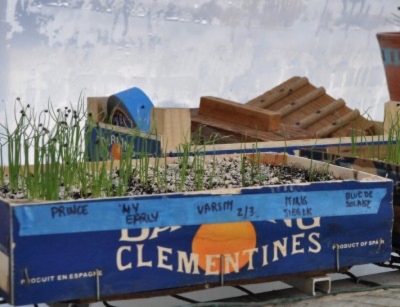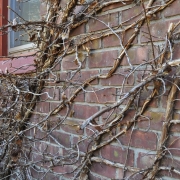Volunteers and Clementine Boxes
Celery Volunteers for Me
I’m always on the lookout for volunteers in my garden, whether they’re people, fungi, plants, or any other organisms. The relationship is usually symbiotic. Human volunteers gain some knowledge and experience; I get some help in my ever-growing farmden. Fungal volunteers work with my plants, drinking in some of the sugars and other goodies plants produce. In return, the fungi protect plants agains certain pests and, in the case of mycorrhizal fungi, fungal threads ramifying through the soil act like extensions of plants’ roots so plants can absorb more nutrients.
But what do plant volunteers get out of our arrangement? Plant volunteers usually arrive in droves so only some can stay. Those that stay get to enjoy especially good growing conditions.
Which brings me to celery.  For the past few years, I’ve allowed celery in the greenhouse to go to seed each fall. The seeds drop and, within a few months, sprout to furnish plenty of seedlings for early summer celery in the greenhouse and later celery out in the garden. All of which is most welcome because celery seedlings are very slow to germinate and grow. Before celery volunteered around here, I had to sow seeds in early February in seed flats, keep the flats warm and moist until the seeds sprouted, transplant the sprouts into individual cells in another flat, and finally transplant the seedlings, after about 10 weeks of care, out into their permanent homes.
For the past few years, I’ve allowed celery in the greenhouse to go to seed each fall. The seeds drop and, within a few months, sprout to furnish plenty of seedlings for early summer celery in the greenhouse and later celery out in the garden. All of which is most welcome because celery seedlings are very slow to germinate and grow. Before celery volunteered around here, I had to sow seeds in early February in seed flats, keep the flats warm and moist until the seeds sprouted, transplant the sprouts into individual cells in another flat, and finally transplant the seedlings, after about 10 weeks of care, out into their permanent homes.
Robust celery seedlings have sprouted and are now growing in a greenhouse bed and in the paths near near that bed, all without any help at all from me. I just lifted clumps of them, separated the seedlings carefully to minimize root disturbance, and “plugged” them back into the ground 8 inches apart. Pest problems are minimized because their new home is a greenhouse bed where celery hasn’t grown for the past two years.
Seedlings from another clump when into individual cells of the APS Propagator; they’ll go outside into the garden in late April. I pulled a few leaves off all these transplanted seedlings so that they don’t lose too much moisture while waiting for their roots to settle into their new homes and get to work.
A lot of celery volunteers are still standing there in the paths and old celery bed. They are now weeds.
Ventura is the One for Me
Slow germination and growth, along with the need for a very rich and constantly moist soil, make celery more of a challenge to grow than most other vegetables. Which is one reason that I grow it!
And there’s more. If seedlings are exposed to temperatures that are too cold for too long (55° or less for 10 days or more), the plants bolt, sending up seed stalks instead of growing thick, succulent leaves. Older books also talk about blanching celery, that is, piling soil up around the leaf stalks so they turn pale and tender from lack of sunlight. My celery rarely bolts, and I never blanche it.
One reason for my success with celery (besides, I hope, a greenish thumb) is the variety I grow: Ventura. This variety doesn’t need blanching and is grow thick crisp stalks with rich, but never harsh.
The best celeries I’ve grown were fairly large volunteers that I moved from the greenhouse path into a greenhouse bed one fall. I covered the plants for a few days to increase humidity while the roots were taking hold. All winter, those plants made the juiciest, longest, tastiest celery stalks ever.
Clementines are for More than Just Eating
Clementines are as tasty as the boxes they come in are useful. I can’t bear to throw those boxes out so have a stack of them waiting to be of use.
One box is home to my seed starting supplies: various dibbles and spatulas for lifting small seedlings to replant into larger flats; various sized pieces of plywood for firming soil in seed flats, some with dowels glued to their bottoms to lay out mini-furrows; tape and marking pens for labeling flats; popsicle sticks, also for labeling.
Two other boxes are now being used as seedling flats – for onions and leeks, sown in early February and now well on their way. Each box has 5 mini-furrows in which I sprinkled about 7 fresh onion or leek seeds per inch. The seedlings will grow in those boxes until transplant time, which is a couple of weeks before I’ll be planting out the Ventura celery.



Hmmm, I grew Lovage once. Similar to celery in looks and taste. It was pretty easy to grow, but alas, not celery. It was good in salads and soups. I love the clementine planting box! Another would look good full of succulents!
I also grew lovage — once. The taste is too, too strong for me.
I don’t grow celery, but I do grow celeriac which I love. My plants are huge and in the basement because here in Ann Arbor it’s still cold. Brilliant has performed well for me. My peas did not. Fully half rotted in the soil and I’m not sure why. I plant in raised beds and wait until April to put them in. I don’t use treated seed. Perhaps I should. Any thoughts?
Peas could have rotted because the soil was too wet, although unlikely with raised beds. Could the problem be a hungry mouse or other rodent? Try sprinkling cayenne and garlic powder on the seed just before you cover them in the furrow; that might help if something is eating them.
I’m going to give celeriac a try yet again.